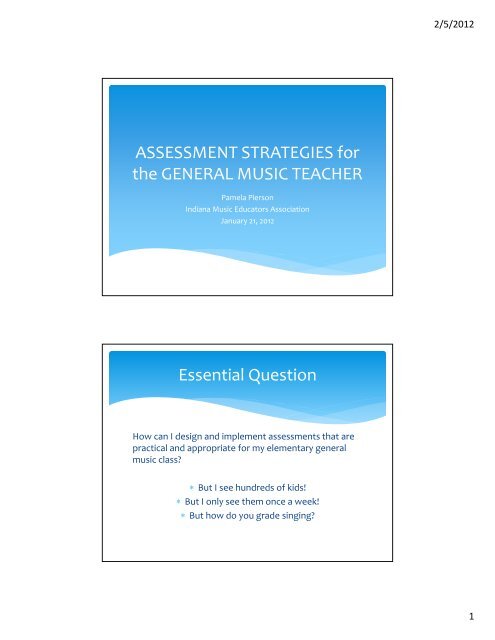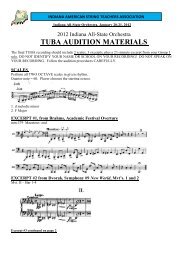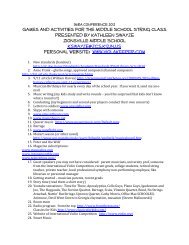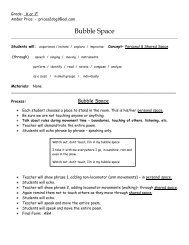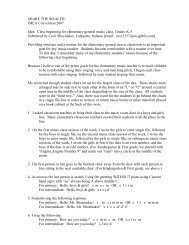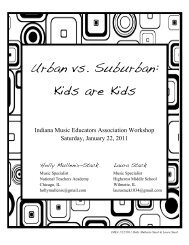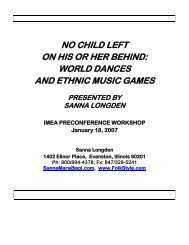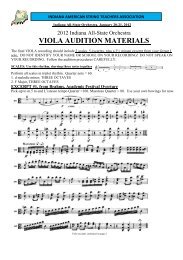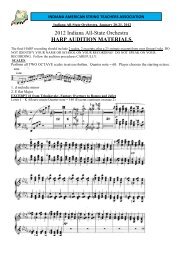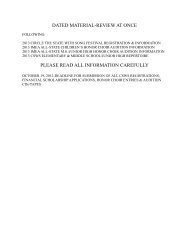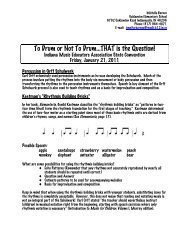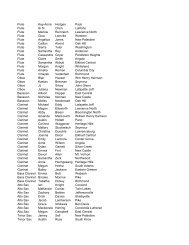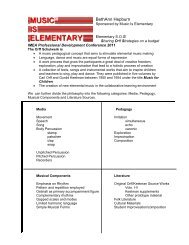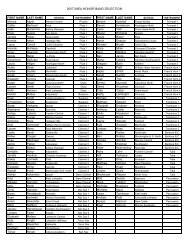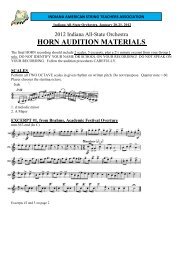ASSESSMENT STRATEGIES for the GENERAL MUSIC TEACHER ...
ASSESSMENT STRATEGIES for the GENERAL MUSIC TEACHER ...
ASSESSMENT STRATEGIES for the GENERAL MUSIC TEACHER ...
Create successful ePaper yourself
Turn your PDF publications into a flip-book with our unique Google optimized e-Paper software.
2/5/2012<br />
<strong>ASSESSMENT</strong> <strong>STRATEGIES</strong> <strong>for</strong><br />
<strong>the</strong> <strong>GENERAL</strong> <strong>MUSIC</strong> <strong>TEACHER</strong><br />
Pamela Pierson<br />
Indiana Music Educators Association<br />
January 21, 2012<br />
Essential Question<br />
How can I design and implement assessments that are<br />
practical and appropriate <strong>for</strong> my elementary general<br />
music class?<br />
But I see hundreds of kids!<br />
But I see hundreds of kids!<br />
But I only see <strong>the</strong>m once a week!<br />
But how do you grade singing?<br />
1
2/5/2012<br />
Why does assessment matter?<br />
“I believe that arts education –music education‐ should be<br />
its own reward. However, <strong>the</strong> reality is, and this is <strong>the</strong><br />
message I want to leave with you, is that that’s not going to<br />
be enough anymore. In education in this country, and in<br />
education in o<strong>the</strong>r parts of <strong>the</strong> world, <strong>the</strong>re’s tremendous<br />
competition <strong>for</strong> time and resources. If you’re not<br />
accountable, if you can’t demonstrate that your kids are<br />
learning something that’s important, you aren’t even in <strong>the</strong><br />
conversation.”<br />
‐Howard Garder<br />
“The primary goal of grading and reporting is<br />
communication. Grading and reporting are integral parts of<br />
<strong>the</strong> instructional process. When done well, <strong>the</strong>y provide vital<br />
in<strong>for</strong>mation to students, parents and o<strong>the</strong>r interested<br />
persons that can be used to enhance both teaching and<br />
learning. …grading and reporting certify attainment of<br />
learning goals, identify where additional work is needed, and<br />
provide a basis <strong>for</strong> improvement ef<strong>for</strong>ts…”<br />
‐Robert Marzano<br />
2
2/5/2012<br />
To summarize….<br />
Assessment in <strong>the</strong> general music class is important…<br />
To obtain evidence of musical growth and progress<br />
To guide instruction and choice of teaching strategies<br />
To help validate <strong>the</strong> music program with parents and<br />
students.<br />
To provide evidence of accountability <strong>for</strong> student<br />
learning.<br />
‐Timothy S. Brophy<br />
“Assessing <strong>the</strong> Developing Child Musician:A Guide <strong>for</strong> General Music Teachers”<br />
Achievement VS Ef<strong>for</strong>t<br />
Is classroom behavior an appropriate measure of<br />
musical progress?<br />
3
2/5/2012<br />
Determining an EFFORT Grade<br />
Seating chart tracking<br />
Determining an ACHIEVEMENT Grade<br />
“To help avoid frustration over what should be assessed,<br />
each teacher must develop a hierarchy of assessable<br />
components based on <strong>the</strong> following considerations:<br />
1. Its importance within <strong>the</strong> overall curriculum<br />
2. The number of minutes allotted <strong>for</strong> music instruction per<br />
week<br />
3. The value of <strong>the</strong> results to <strong>the</strong> overall assessment<br />
scheme.”<br />
4. ‐Timothy S. Brophy<br />
4
2/5/2012<br />
The Concepts that “Drive” My<br />
Curriculum<br />
Pitch & Rhythm….<br />
….through literacy &<br />
per<strong>for</strong>mance<br />
Target Practice<br />
(Credit to Craig Early)<br />
Introducing <strong>the</strong> target concept to a class (include a<br />
picture from my classroom)<br />
Familiar song “Apple Tree”<br />
Providing feedback to students using a mini‐target<br />
5
2/5/2012<br />
DMC: Daily Music Challenge<br />
(credit to Susan Lough, Churubusco Elementary)<br />
A program of rhythmic development whereby students<br />
begin class by reading, thinking and/or per<strong>for</strong>ming<br />
through clapping a rhythm pattern that includes specific<br />
rhythmic values identified <strong>for</strong> each grade level.<br />
Individual assessment can include: maintaining a<br />
checklist, popsicle sticks, accompaniment of DMC<br />
rhythm to accompany a song, etc.<br />
Keeping Track of Individual<br />
Per<strong>for</strong>mance<br />
Melodic Comprehension Evaluation Form<br />
Rhythmic Comprehension Form<br />
6
2/5/2012<br />
Additional Rubrics<br />
To evaluate projects<br />
To evaluate choral per<strong>for</strong>mances or general music<br />
concerts<br />
In closing….<br />
Assessment and evaluation<br />
demonstrate <strong>the</strong> INTEGRITY of<br />
you bring to your music program.<br />
7
2/5/2012<br />
Helpful Resources<br />
“Assessment in <strong>the</strong> Music Classroom: Practical Tips and Activities<br />
<strong>for</strong> Measuring Student Progress.” Cristi Cary Miller. Hal Leonard.<br />
“The Ultimate Music Assessment and Evaluation Kit <strong>for</strong> <strong>the</strong><br />
General Music Teacher: Practical Strategies, Time‐Saving Tips,<br />
Samples, Forms and More.” Cheryl Lavender. Hal Leonard.<br />
“Assessing <strong>the</strong> Developing Child Musician: A Guide <strong>for</strong> General<br />
Music Teachers.” Timothy S. Brophy. GIA Publications. 2000<br />
Teacherspayingteachers.com (look <strong>for</strong> items by 2musicpeeps)<br />
8
MELODIC COMPREHENSION EVALUATION FORM <strong>for</strong> ____________________________________ <br />
Music Teacher: K _______ 1 _______ 2 _______ 3 _______ 4 _______ 5 _____ <br />
1–minimal achievement 2–below average achievement 3-‐average achievement 4-‐superior achievement <br />
MELODIC COMPREHENSION: Student identifies pitch from notation <br />
K 1 st 2 nd 3 rd 4 th 5th <br />
NOTES: <br />
s-‐m <br />
s-‐m-‐l <br />
s-‐m-‐d <br />
l-‐s-‐m-‐d <br />
l-‐s-‐m-‐r-‐d <br />
l-‐s-‐m-‐r-‐d-‐s’ <br />
d-‐l-‐s-‐m-‐r-‐d-‐s’ <br />
d-‐l-‐s-‐m-‐r-‐d-‐l’-‐s’ <br />
d-‐l-‐s-‐f-‐m-‐r-‐d-‐l’-‐s’ <br />
d-‐t-‐l-‐f-‐s-‐m-‐r-‐d-‐l’-‐s’ <br />
MELODIC COMPREHENSION: Student sings pitches accurately. <br />
K 1 st 2 nd 3 rd 4 th 5th <br />
s-‐m <br />
s-‐m-‐l <br />
s-‐m-‐d <br />
l-‐s-‐m-‐d <br />
l-‐s-‐m-‐r-‐d <br />
l-‐s-‐m-‐r-‐d-‐s’ <br />
d-‐l-‐s-‐m-‐r-‐d-‐s’ <br />
d-‐l-‐s-‐m-‐r-‐d-‐l’-‐s’ <br />
d-‐l-‐s-‐f-‐m-‐r-‐d-‐l’-‐s’ <br />
d-‐t-‐l-‐f-‐s-‐m-‐r-‐d-‐l’-‐s’ <br />
NOTES:
MELODIC COMPREHENSION EVALUATION FORM <strong>for</strong> ____________________________________ <br />
Music Teacher: K _______ 1 _______ 2 _______ 3 _______ 4 _______ 5 _____ <br />
1–minimal achievement 2–below average achievement 3-‐average achievement 4-‐superior achievement
RHYTHMIC COMPREHENSION EVALUATION FORM <strong>for</strong> ____________________________________ <br />
Music Teacher: K _______ 1 _______ 2 _______ 3 _______ 4 _______ 5 _____ <br />
1–minimal achievement 2–below average achievement 3-‐average achievement 4-‐superior achievement <br />
GRADE 1 <br />
Evaluation Date <br />
Steady Beat <br />
Identify name of note <br />
Read a rhythm <br />
Per<strong>for</strong>m with BP <br />
Per<strong>for</strong>m on an instrument <br />
Compose <br />
GRADE 2 <br />
Evaluation Date <br />
Steady Beat <br />
Identify name of note <br />
Read a rhythm <br />
Per<strong>for</strong>m with BP <br />
Per<strong>for</strong>m on an instrument <br />
Compose <br />
GRADE 3 <br />
Evaluation Date <br />
Steady Beat <br />
Identify name of note <br />
Read a rhythm <br />
Per<strong>for</strong>m with BP <br />
Per<strong>for</strong>m on an instrument <br />
Compose <br />
GRADE 4 <br />
Evaluation Date <br />
Steady Beat <br />
Identify name of note <br />
Read a rhythm <br />
Per<strong>for</strong>m with BP <br />
Per<strong>for</strong>m on an instrument <br />
Compose <br />
GRADE 5 <br />
Evaluation Date <br />
Steady Beat <br />
Identify name of note <br />
Read a rhythm <br />
Per<strong>for</strong>m with BP <br />
Per<strong>for</strong>m on an instrument <br />
Compose


